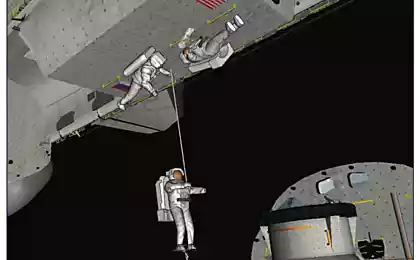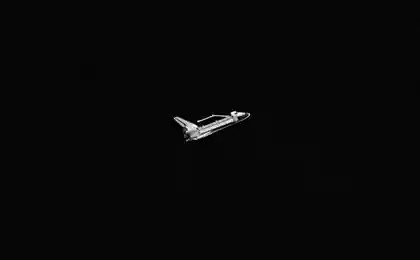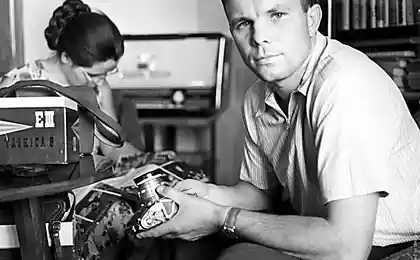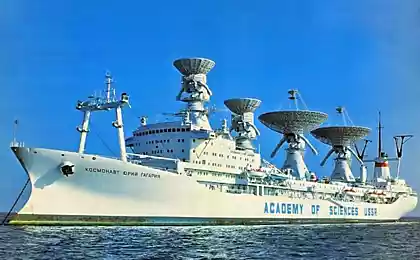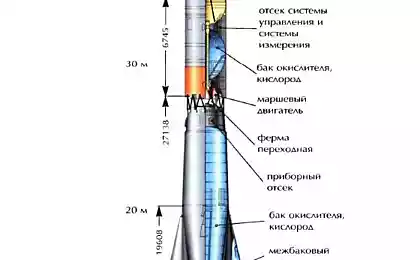The first part you can read
here .
 Specialists team flight STS-107 Laurel B. Clark, Rick D. Husband and Kalpana Chawla rest in their beds on the middle deck. Source: NASA / WikiMedia Commons i>
Specialists team flight STS-107 Laurel B. Clark, Rick D. Husband and Kalpana Chawla rest in their beds on the middle deck. Source: NASA / WikiMedia Commons i>
The show begins h4>
«Power outage would leave in working condition only the most basic modules ship control, life support and communications.» B>
- From the application D.13 report of the Commission of Inquiry of the shuttle disaster "Colombia» i>
While on earth would work was to maintain a controlled madness on "Colombia" time stretched to and proceeded slowly and poorly. In the future, the team could wait a short burst of activity, in that case, if they had to make a sortie to confirm the damage of the left wing of the shuttle. In addition, they would have to change the position of the ship, putting his nose up, because in such a state of gravity acting on the tail of the ship, would help save fuel. However, after that, the team ranked in the disaster could do virtually nothing but wait and try not to move or breathe more than you need.
The team would not have even the opportunity to watch TV shows about how the rescue operation, as the ship would pass mode is strictly limited use of energy in order to conserve its reserves. Appendix D.13 contains a description of what you had to turn off the system and among them are given "all the cameras and their heaters, TV monitors and video equipment.»
Often heard the question was whether the "Columbia" the opportunity to dock to the ISS, which could share free reserves. There are a huge number of reasons why this was not possible, but the most determined from them are reduced to simple physics: "Colombia" would have to perform a maneuver that, in the terminology of celestial mechanics is called the "change of orbital inclination", giving engine thrust perpendicular to the line of the orbit, to achieve equal inclination inclination orbit at the ISS. This change requires a tremendous amount of energy, in some cases even more than is required for the launch of the space ship itself. Appendix D.13 excludes this possibility closer to the ISS just two sentences:
«Bring 39 degrees inclination orbit" Columbia "in line with the value of inclination of 51.6 degrees to the ISS was impossible, as it would require the translational motion of the resource value of 12 600 ft / sec. In "Columbia" was available to only 448 ft / cek. » I>
The team engaged in a long game, carefully saving resources for a rude awakening that was to have happened at the very end of the mission. As noted earlier, the very first in the list of resources consumed were carbon filters, so rest and sleep would be the main objectives of the team. "Columbia" have stayed in orbit for so long that during his quiet exile, more than three hundred times the crew would meet the sunrise, watching as it rises from the edge of the planet.
How long would the time dragged on for them? How many times could play cards, how many jokes or stories to tell? How many times have they scroll planned rescue operation in mind, sitting in his bunk, smelling bad, deprived of the possibility to take a bath, among six such bad smelling and frightened people, considering each of the 30,000 endless minutes?
That would have been more than 20 days of endless and painful drift.
Russian Roulette h4>
«The emergence of new threats to ships sail and his team would play a significant role in the decision making process of its launch.» B> i>
- From the application D.13 report of the Commission of Inquiry of the shuttle disaster "Colombia»
Appendix D.13 written on the assumption that the damage done to "Columbia" would be detected in time and appropriate measures have been taken. However, this is only one of two assumptions underlying the rescue mission. The second assumption has a number of very important conditions of their own. Given that the "Columbia" was derived from a standing blow a piece of foam, NASA would have to voluntarily agree to subject the "Atlantis" to the same risk.
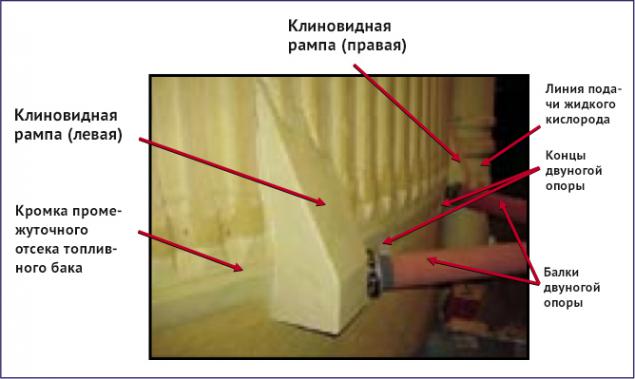
An approximate picture of the attachment left ramp (a piece of foam), which came off during launch flight STS-107. Source: NASA / CAIB Report, Appendix D.13 i>
Scary question that suggests itself: Could NASA, for the short time that she was to do something to protect the "Atlantis" from the same fragment of impact? Definitely not.
A piece of foam broke away from the external fuel tank "Colombia" was part of the design, which is called the left "rail bipedal support", one of two such parts manufactured by hand and on the sides adjacent to the huge bipedal support, which enshrines the nose to the front of the shuttle external tank . These ramps are formed by spraying the orange insulating material BX-250 to fixtures that combine bipedal support external fuel tank. He is allowed to dry and then polished to give it a wedge shape, which covers these fixing. Together with a layer of ablative material overlay on top mounts, these ramps foam protect the compound from the high temperatures during start-up, and, moreover, gives it a streamlined shape.
As it turned out, the supports already racked up a flight of six times.
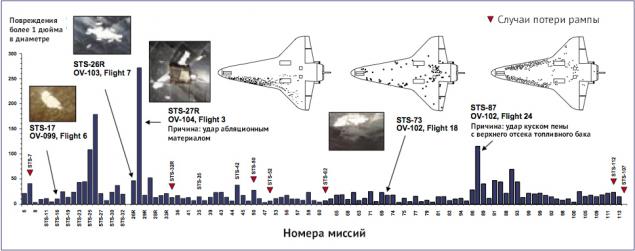
Увеличить / The amount of damage on the surface of the shuttle with a diameter of more than one inch for flights from STS-6 and STS-113.
Cases in which the loss was fixed foam ramp marked with a red triangle. Source: NASA / CAIB Report, Appendix D.13 i>
Discussion of the features of the thermal insulation of the external fuel tank devoted a substantial part of the report CAIB. It was found out what material it is made, how this material behaves and how often foam chips from the tank and hits the ships before. From the report it becomes quite clear that the foam strike was not anything uncommon. Previously, it was a common occurrence, which in this case occurred in the most appropriate (inappropriate) moment to inflict catastrophic damage on one of the few parts of the shuttle, which did not have any margin of safety.
Rescue mission "Atlantis" would be faced with the same vulnerability. She would fly with pre-prepared fuel tank, and the information from the report clearly indicates that, in this scenario, the verification procedure will not be extended for any assessment of the state of repair or used tank.
And this is another reason why the team would consist of no more than four astronauts: it was necessary to reduce the number of people who will be jeopardized.
Gravity ballet h4>
The criterion of success of the operation: the return of the rescue vessel ("Atlantis"), and both teams intact. B> i>
- From the application D.13 report of the Commission of Inquiry of the shuttle disaster "Colombia»
The "Atlantis" would be three windows to start and the flight to the "Columbia": the first - at 23:09 on the central eastern time on February 9 (25 day flight), the second - at 22:40 the next day, and last through the day after the first at 22:05. "Columbia" was to prepare for a meeting with his ship companion three days before the first window. Crew members are likely to suffer the effects of poisoning by carbon dioxide, restart the system to the shuttle so that their work was enough for a small change in the height of the elliptical orbit that would provide the "Atlantis" larger set of choices for a rapprochement.

«Colombia" on launch pad 39A. The upper circle represents the left ramp to the upper attachment point, the bottom circle - heat shield panel of carbon-carbon ceramic material. Source: NASA / CAIB Report, Appendix D.13 i>
Weather is one of the major uncertainties during planning shuttle launch, not only for the launch pad, but also for a variety of locations around the world, which should be ready for an emergency landing, if the ship must stop its attempt to reach orbit. CAIB report shows that, in this respect, luck was on the side of NASA: an overview of the observed weather conditions anticipated launch days showed that the Earth's atmosphere does not happen anything that would prevent the launch.
However, much more concern was that fact that all three windows were open at night. Night launch would materially lessen the possibility of damage from NASA to observe a similar piece of foam collision with the vehicle during its flight into orbit, the more that did not bode well, given that this would be the cause of the rescue mission. That's why the team "Atlantis" had another foray out after arriving to the "Columbia": they have carefully examined both wings and ceramic lining for possible damage.
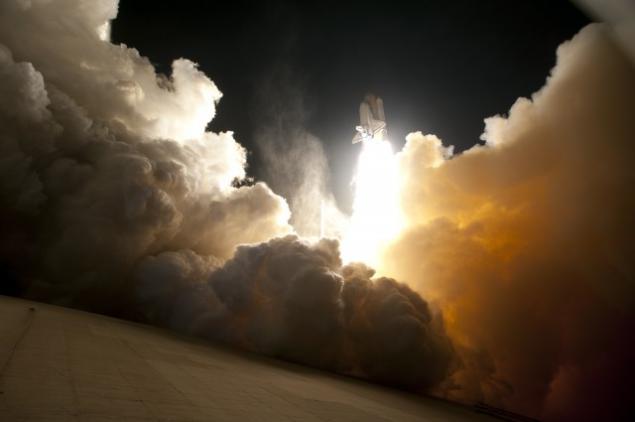
«Endeavour" starts with a platform to carry 39A flight STS-130 in February 2010. Source: NASA i>
Assuming that all goes well and the countdown will not be delayed, "Atlantis" was launched in the evening to 9 February 2003. By this time, the team "Columbia" has long been put to the historical record for the shuttle program, they would have spent 25 days in space, which would be 8 days longer than previous missions. Astronauts 'Atlantis', selected for access to space, it was necessary to reduce the nitrogen content of the blood and be ready to wear suits as soon as possible, so they probably would have had to breathe pure oxygen from the moment when they would fall into the compartment before cartwright the launch.

«Endeavour" on the approach to the ISS. The image shows a detailed view of the front of the flight deck, its upper windows, designed to track the process of docking and docking assembly rear deck. Source: NASA. I>
"Atlantis" would head up into orbit on the arc of the trajectory approaching the "Columbia" on a "rapprochement against the line of the orbit." This means that he would fly to her by an imaginary line that connects the point location "Colombia" and the center point of the Earth (as opposed to "convergence line orbit" when he approached her to be on a line of its velocity vector, front or rear, rather than above or below). "Columbia", by this time, already would be located in the space of "nose up", looking at the rear of his land.
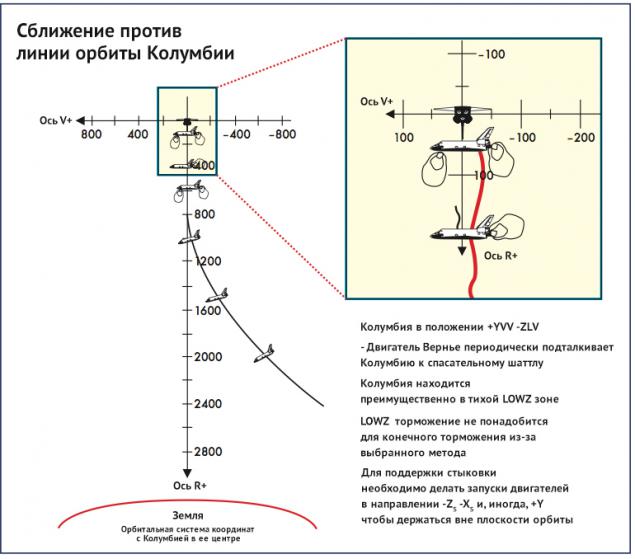
Source: NASA / CAIB Report, Appendix D.13 i>
Ultimately, the "Atlantis" has lowered the velocity to stop at 6 meters from the "Columbia". He would have been rotated by 90 degrees with respect to it, looking at 3 o'clock in relation to 12 hours older ship that does not give them the vertical stabilizer hit each other.
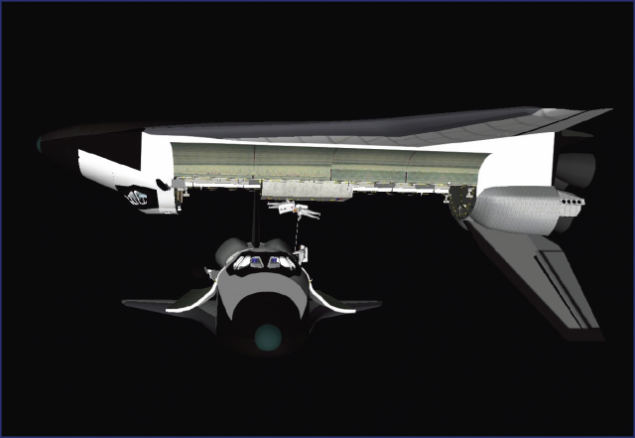
"Atlantis" keeps docking c "Columbia". Source: NASA / CAIB Report, Appendix D.13 i>
For the first time in history, two of the shuttle would be placed in orbit together and they both had to go through a severe test. Shuttle flight would be controlled from the inside of each of them, and from the Mission Control Center, NASA. In addition, at the same moment, the PMU had also monitor the flight and the ISS. This would require multi-tasking to the limit MCC, both from a technical point of view and from the point of view of the available human resources. Moreover, the "Atlantis" would require continuous manual control at all the time of docking, because even at a distance of 6 meters, the laws of celestial mechanics would make the two vessels moving at different speeds, which is why they went to pretty quickly. "Atlantis", which would be on a smaller compared to the "Columbia" in height, it would constantly overtake her.

The layout of the cockpit of the space shuttle in a special simulator CCT-2 Center of training simulation space shuttle NASA. On the console, located in the middle of most of the controls in height and movement, which were used to the commander and pilot of the "Atlantis" for flying and rendezvous with "Colombia". Source: Steven Michael i>
At that time, the pilot and commander of the "Atlantis" would suit in the control room and succeeded each other in the course of the task to retain permanent docking, the other two members of the crew, which the report called EV1 and EV2, were already have a lock chamber, wearing spacesuits. After receiving the command, they dug would hatch and pulled the sliding pole, with which would help EV2 EV1 (EV - EVA - approx. Interpreter) to get to the "Columbia" through the space between the two shuttles. Together with a couple of suits for the crew, "Colombia", rescuers also passed the extra capacity with LiOH, to, literally, give them the opportunity to breathe deeply. The application stated that the suits had to pass, "establish the work of their systems and seal", in order to preserve their water supply, which, no doubt, would have looked quite unusual.
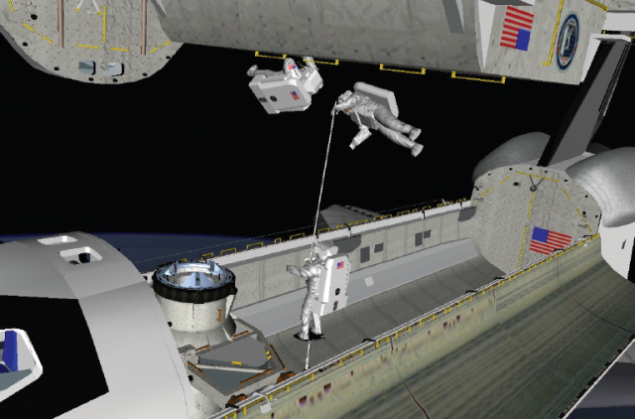
Animation frame NASA, which shows two astronauts 'Atlantis' cargo bay located between the two shuttles. EV2 is standing on a laptop latch for the legs and moves EV1 through the free space between the shuttle. Source: NASA / CAIB Report i>
Two crew members (called CM1 and CM2), no doubt suffering from mental disorders due to prolonged stay in such conditions, to this point would have already been dressed in suits and waited in the airlock, "Colombia", in order to assist in carrying things with "Atlantis". EV1 transferred to reserves in the airlock, "Colombia", then helped CM1 and CM2 would get out of it and get to the "Atlantis».
to be continued in the third and final part ... i>
Source: habrahabr.ru/post/216555/












